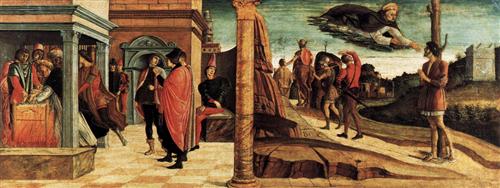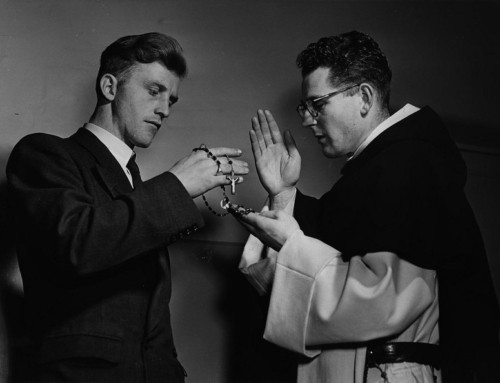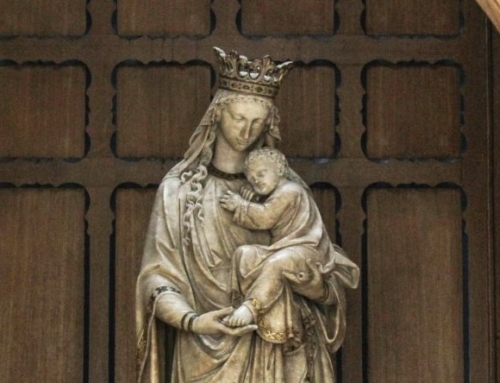Laura Ackerman Smoller, The Saint and the Chopped-Up Baby: The Cult of Vincent Ferrer in Medieval and Early Modern Europe. Ithaca: Cornell University Press, 2014.
The Saint is not his own. And neither is the story of a saint possessed solely by his country, his order, or even the Church. The Saint and the Chopped-Up Baby details the development and growth of the cult of the Dominican friar St. Vincent Ferrer, following his death in the early fifteenth century. While the title suggests a lively tale of piously held beliefs regarding the “Angel of the Apocalypse,” this work by Laura Ackerman Smoller proves to be an engaging, strictly factual account of how the traditio of St. Vincent Ferrer began to take shape. Instead of the life of the saint, The Saint and the Chopped-Up Baby tells the development of how his life came to be viewed and used in the generations after his death.
A controversial figure in his day, St. Vincent Ferrer preached the Gospel for the salvation of souls at a contentious period in history. A vocal defender of the Avignon Papacy during the Western Schism, he sought to bring support to his close friend and confessee (the antipope) Benedict XIII. A Spaniard by birth, St. Vincent entered the Order of Preachers around the age of eighteen. Later, he became a famed master of sacra doctrina in his own right. However, after many years of teaching and service, he left everything to follow a call from the Lord to preach repentance. Tasked with the mission to preach throughout Europe, he spent the last twenty-one years of his life at the head of a traveling band of preachers, proclaiming the coming Judgment. He died in 1419.
After recounting basic biographical information about St. Vincent Ferrer, Smoller details the lengthy canonization inquiries and processes, ultimately culminating in his canonization in 1455. Late medieval canonization inquiries themselves were subject to strict liturgical customs and methods, and the author navigates them well. While the narration at times becomes bogged-down in excess description, the picture given is nonetheless riveting. The accounts of his canonization tell of an impressive ceremony (with at least four hundred Dominican friars in procession) for the celebration of St. Vincent being raised to the Church’s altars.
Subsequent to his canonization, several biographies of the saint were written, and the story of his life began to take on a more definite shape. Each work emphasized different aspects that would have had special meaning for the intended audience. Eager to overlook both his association with the Avignon popes and his predictions about the impending apocalypse, the saint’s biographers focused on his intercessory power in healing those affected by the plague, his preaching of repentance, his work for the end of the Schism, and other more fantastic tales of miraculous deeds. One such story, the tale of the chopped-up baby from which this book takes its title, grew to have special importance. The legend of St. Vincent miraculously reconnecting and resurrecting a quartered child, either through his intercession or his direct aid, may seem like little more than a fantastic tale. However, while viewing them somewhat humorously, Smoller does point out that these sorts of legends have a purpose; they came to be seen as an allegory for the reunification of the Church as well as a story rich with Eucharistic imagery.
Smoller argues that often the lives of the saints tell us more about the culture and priorities of the authors than about the saints themselves. If, as Aristotle argues, history is not a science but rather an art, the twelve authors who composed lives of St. Vincent Ferrer were artists who endeavored not to be Realists but rather Impressionists. While the canonization inquests were often tedious and meticulously factual affairs, the subsequent written lives tended to go in different directions, showing the big picture but also bringing into relief certain pious aspects of the saint. Whether they were to emphasize the observant strand seen in St. Vincent’s appreciation for strict adherence to the Constitutions of the Order of Preachers, or the legitimacy of the Breton royal family, lives of St. Vincent Ferrer were written as catechetical, polemical, and exhortative works intended for specific readers in specific places.
So, whose saint is St. Vincent Ferrer? Is he the hero of Breton, the exemplar Dominican, the figure of Church unity, the Spanish ideal, or even the popular saint of the New World? In the end, a saint is a saint for the Church, not for himself or herself. St. Vincent Ferrer lived for the love of God. However, as the life of his afterlife convincingly shows, the saint takes on new meaning for the people inspired by his example. The Dominican, the priest, the saint, is not his own man. We appropriate the lives of great saints in order to find powerful intercessors and paradigms for the life of grace. In illustration of this point, Smoller concludes with a personal reflection on a visit to the Dominican Church of St. Vincent Ferrer in New York City, reminding us that the saint continues to serve the Church in the afterlife, even if some of the stories that have edified us have little in common with actual events in the life of the saint.
To download a printable PDF of this Article from
Dominicana Journal, Summer 2015, Vol LVIII, No. 1, CLICK HERE.




